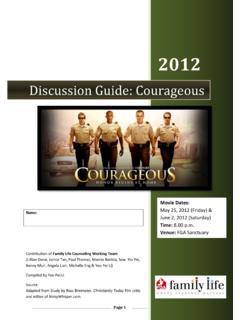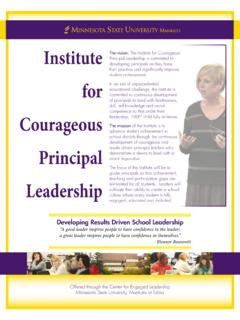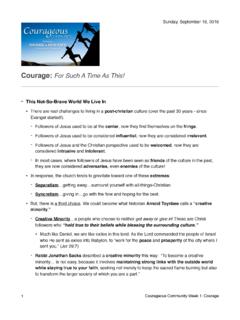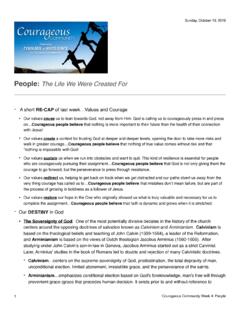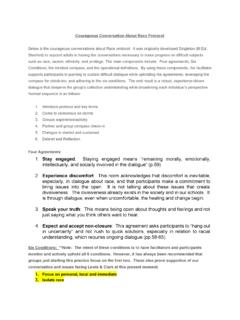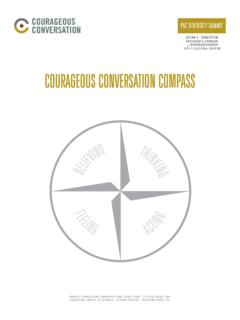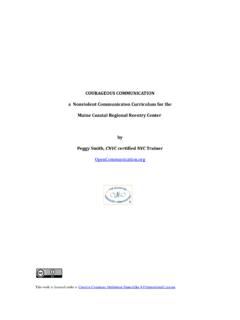Transcription of Courageous Followers, Courageous Leaders
1 Courageous Followers, Courageous Leaders NEW RELATIONSHIPS FOR LEARNING AND PERFORMANCE Ideas for Leaders December 2001 by IRA CHALEFF How many times have you worked in an organization in which bright, mid-level managers were frustrated by the difficulty of influencing senior executives whose leadership style was impeding organizational growth, productivity or morale? Young Turks , as they are sometimes called, are often brimming with energy to innovate and test new ways of meeting organizational challenges. The senior executives, who cultural myth holds to be the change agents, are often mired in old ways of doing things with which they are comfortable.
2 They are the roadblock, not the road, to innovation. Alternatively, these bright, mid-level people, may be dismayed to watch a new senior executive who does not fully appreciate how the company works, start reorganizing, downsizing, outsourcing or merging in ways that will not be viable. Anyone daring to question the new broom is quickly earmarked as someone who needs to go. Silence reigns. A year or two later, the board and the investors are left to clean up the mess resulting from the leader s high-handed style. It is the quality of the relationship of Leaders and followers, all the way up and down the organization chart, that makes or breaks organizations.
3 Those lower down in the organization have more direct experience with its people, processes and customers and need to be able to influence the Leaders thinking on which way the organization should go. They cannot be intimidated by the power and trappings of office of the Leaders to whom they report. Yet, as we know, they often are intimidated. Traditional leadership theory puts the responsibility for the leader- follower relationship with the leader. In my observation, it often works the other way around. Those who work most closely with the leader, the senior followers if you will, need to assume responsibility for keeping their relationship with the leader honest, authentic and Courageous .
4 Yes men need not apply. There are two distinct roles that executives and managers are called upon to play. One is the role of leader in their own right. The other is the role of Courageous follower . Endless attention is paid to leadership qualities, selection, training, development and evaluation. Who ever pays attention to how well these same individuals perform their role as Courageous followers? Virtually no one. Why is this? We are a society in love with leadership and uncomfortable with followership, though the subjects are inseparable. We don t honor followership. We talk pejoratively of followers being weak individuals. And we certainly don t train staff how to be strong followers who are not only capable of brilliantly supporting their Leaders , but can also effectively stand up to them when their actions or policies are detrimental and need rethinking.
5 As a result, the orientation of those around the leader often becomes personal survival instead of group optimization. Optimum group performance requires that both Leaders and followers place the organization s welfare at least on par with protecting their personal interests. As Chris Argyris of Harvard observes, in most groups the individuals are so concerned with avoiding embarrassment or personal threat, they shy away from the conversations that need to occur to fundamentally improve performance. This is the antithesis of the vaunted Learning Organization . Important issues become undiscussable. Where thinly disguised authoritarian relationships still prevail (leader dictates, follower complies or else) team members are driven down Abraham Maslow s hierarchy of motivation.
6 Their needs for physical security and social acceptance outweigh pride in organizational achievement. Instead of risking the conversations that are needed to address leadership s own contributions to mediocre performance, they play the game and conform, regardless of the cost to the organization. If Leaders are exceptionally smart, they create environments in which such honest communication is the norm and rewarded. But, human nature seems to conspire against this and, most of the time, few speak truth to power. If they do so, and they get rebuffed, they don t do it again. Instead, they complain to each other and to their spouses, but no longer to the person who needs to hear the message and do something about it.
7 How many times have you found yourself in this position in an organization? How much do you think this type of behavior costs organizations? But if you find yourself in a follower role with a leader who is not using his or her power well, why should you risk your job by seeking to change the status quo? The simplest answer is because it is a better way to live. Win or lose, you ve carried yourself with integrity and self-respect. The more complex answer is that, if you aspire to senior leadership positions yourself, you d better learn to take risks. Leaders who can t risk, can t lead. Here s a chance to get in practice. How do you go about this?
8 I believe that there is a two part answer to transforming leader- follower relations and creating the conditions in which a learning organization can emerge. The first part has to do with ourselves, the second with the other. At the heart of all transformation of relationships lies transformation of ourselves. This is both where we have the most power to create change and the most reluctance to confront the need for it. In this instance, the process starts with an honest examination of how we have learned to cope with authority relationships. Do we tend to be subservient? Cynical? Prickly and rebellious? Functional, but always playing it safe?
9 These and other patterns exert a price on the relationship. Ideally we would have mature relationships between self-confident, mutually respectful, emotionally and intellectually honest peers, each operating from a prescribed role for the common good. Often this is no more easily achieved between managers and subordinates than it is between forty year old adults and their overbearing parents. Focusing on our own end of the relationship, rather than on what is being done to us, is usually the best place to start. Some of the key points to examine and reflect on include: Am I energetically pursuing the group s purpose and aligning my self- interests with it?
10 Or, am I holding back my full contribution, including my willingness to take risks? Do I need to take more initiative to ensure that the group is effectively pursuing its mission? Will the way I am behaving in this relationship, or in authority relationships generally, permit me to do that, or do I need to try new behaviors? What is my power based on in this situation that would enable me to take greater initiative? What combination of knowledge, skills, reputation, positional authority, networks and communication channels can I bring to bear? Who do I need to align myself with to effectively create the needed change? Why am I hesitant to act?
